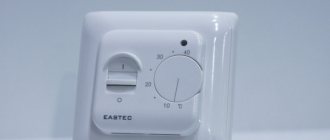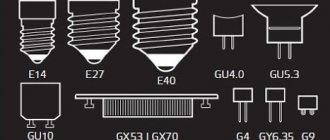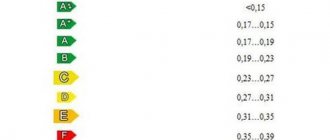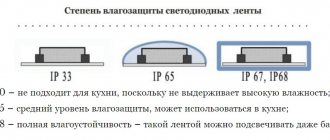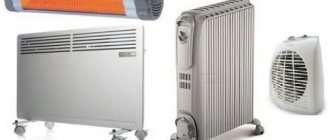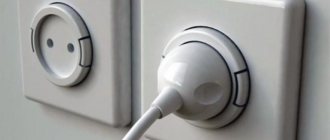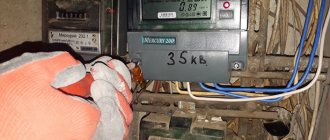Author of the article
Anton Bogdanov
Heat and gas supply and ventilation engineer. Prepares projects for gas supply to private houses.
To keep the room warm when it is already cold outside and the heating has not yet been turned on, household heaters were invented. They will come in handy all year round. For example, in winter not all rooms are heated, or not heated enough. You can put the heater in the garage or, for example, in a temporary shed.
But this heating method also has disadvantages, since heaters have a fairly high energy consumption. Let's figure out how much the heater consumes and how expensive this heating method is.
Electricity consumption
To calculate how many kilowatts a heater consumes, you need to make simple calculations that any user can do.
Does this or that heater consume a lot of electricity? Let's count. Let's take a device with a power of 2 kW or two thousand watts as an example. For an hour of operation, it consumes two kilowatts. Let's imagine that on cold days the heater works eight hours a day, after an hour of operation there is a break for two hours. Sixteen kilowatts are consumed per day. The number was obtained by multiplying the number of working hours by the consumption per hour. The monetary equivalent is calculated simply: the price per kilowatt is multiplied by the number of kilowatts spent. Consumption amounts vary depending on the intensity of use of the device.
The data obtained helps to easily calculate how much electricity is spent per month throughout the cold season. The indicators depend on weather conditions, how often and for how long the heater operates. If we imagine that a particular month was very cold and the device heated the room every day for eight hours, the electricity consumption per month would be four hundred and eighty kilowatts.
To pay the minimum, you need to use climate control technology rationally. Buying a high-quality and suitable heater will allow you to organize minimal electricity consumption, which means it won’t hurt your wallet.
The use of any heating device will result in increased electricity consumption. To ensure that the increase in costs is insignificant, you need to find out in advance basic information about different types of heaters and choose a device with a high-quality thermostat. It is designed to set precise temperature conditions, regulate the operation of the device: turn it on and off, increase and decrease power.
The best option to optimize the process is to purchase a heater with a thermostat or thermostat. If necessary, the timer can be purchased separately.
Traditional heaters that are not equipped with temperature controllers are not the most convenient to use: they must be turned on and off independently depending on the air temperature. It also prevents the room from being preheated before family members arrive.
To eliminate a host of problems and potential dangers, you can purchase a thermostat for your heater.
It will help set the cycle, mode and power of the heating device. The use of thermostats allows you to optimize the heating process due to their functional features:
- You can independently set the desired temperature;
- devices automatically regulate the switching on and off of heating equipment;
- the heater turns on only when the temperature drops to the specified temperature, so it is possible to regulate electricity consumption and normalize the process of resource consumption;
- You can independently control the microclimate in the room, preventing the air from drying out.
Electronic, electromechanical thermostats and thermostats for infrared heaters are available for sale. GSM and WI-FI adjustable controllers have appeared.
Having equipped a thermostat, you begin to independently control the consumption of electrical energy - this is the main advantage of the device. Installing a thermostat has many advantages:
- function of automatically reducing the network load by fifty percent;
- full heating even with reduced network load;
- the ability to control every kilowatt of electricity;
- setting individual temperature conditions for any room;
- daily and weekly cycle programming;
- ease of operation;
- no clicks when changing operating mode.
The thermostat can be installed at a distance from the heater, on its surface or inside the device.
Types of electric oil heaters
But there are also key differences between the two classes, which will be mentioned later. Here we note the main thing: the fan heater is strongly tied to the air flow; if it is impossible to supply the full volume for blowing, the device will turn off due to internal overheating protection, releasing noticeably less heat into the room than stated by the manufacturer.
Within an hour of operation of the thermal panel, the temperature in the room immediately increased by 2°C: from 18.8C to 20.8C. During this time, the heater “ate” electricity for 1.65 rubles. That is, it consumes the same amount as an oil radiator, but is twice as efficient. In connection with changes in the economy and the family budget getting thinner before our eyes, the question arises about ways to reduce spending. Why not start saving on electricity? In winter, you want your apartment or work to be warm, and if heating and insulated windows do not help, then a heater will help.
How much does an infrared heater consume 2 types of device
There is a room of 17 m2 and central heating, which maintains a room temperature of 20 degrees. What will be the daily energy consumption if I use a convector to increase the temperature in the room to 25 degrees?
I would really like to know about detergents and cleaning products for the most common surfaces, such as a bathtub, toilet, kitchen, microwave... and cleaning products, the cheapest, the most expensive, and the middle???
The oil cooler is self-sufficient. Depending on the volume, the warm-up time may vary. But after the device is in operating mode, it shows excellent characteristics of economy and efficiency. The heating elements are turned on for a short time, the radiator almost always has the same temperature.
The clear winner was the convection heater: maximum heat for average money. The only limiting factor is the price.
7De'Longhi GS 770715
De'Longhi GS 770715 is a new generation radiator that is equipped with special thermal cells. With their help, the surface temperature of the device remains at the optimal level during operation, thereby complying with generally accepted safety standards. An adjustable thermostat allows you to maintain the optimal temperature throughout the entire operating time. Three operating modes will allow you to choose the best option for rooms of different sizes, and will also save energy. For convenience, the engineers added adjustable wheels; with their help, the heater can be easily moved to another room.
An additional function is frost protection. This feature will help those who often leave the heater in a cool room.
pros
- Multiple heating modes
- Quickly heats a room up to 20 sq. m
- Doesn't stink while working
- Good build quality
Minuses
- The cord is a bit short
- Occasionally it clicks softly
Oil radiator
The classic type of heater and the slowest, in my opinion.
Principle of operation:
- First, the filler (oil) is heated by means of a hidden heating element or spiral;
- then the case warms up;
- After this, the heat begins to spread into the environment.
That is, an oil fireplace heats the air, but the walls, floor and objects around remain cold. In addition, the device needs time - and a lot - to heat the case. Typically, such devices have a power of 1-2.5 kW and are not economical. Suitable for use in small rooms with a closed door. I wouldn’t buy such a heater for a home, but it belongs in an office. The advantage of such devices is that you can dry things on them, which is very convenient if you commute to work on a rainy day. The big disadvantage is that the oil cooler is short-lived; the older the model, the more dangerous it is due to the fact that oil can leak out and cause a fire or burn.
Conclusion: oil-based devices are inferior to other types of heaters in terms of efficiency, performance and safety.
Installation
Installation of the heater does not require special skills and knowledge. If it is a hanging model, it is mounted on brackets that are pre-installed at the required distance from each other. If the model is mobile on wheels, then all that is needed for installation is to determine the safest place near the outlet. It is worth considering that there should be no obstacles in the heater’s path - curtains, sofas or chests of drawers. It is best to install it in the central part of the room in the first 2-3 hours of operation. After the space has warmed up, it is moved to a more comfortable distance - near a wall or fireplace.
How much electricity can household electrical appliances consume?
1. Computer
Calculations that will show how much electricity a computer consumes will be carried out approximately, since everything depends on the power of your computer’s power supply and the specific work that the computer is performing at the moment.
For example, if the power of a computer unit is from 350 to 550 Watts, it is unlikely to consume all the power even under full load. It is also necessary to take into account the monitor - from 60 to 100 watts. In total, with an average computer power supply of 450 Watts and a monitor of 100 Watts, you get 550 Watts or 0.55 kW of electricity per hour. This figure is greatly overestimated. For an approximate calculation, you can take the maximum value - 0.5 kW/h. Thus, when using a computer 4 hours a day, the result is 60 kW/h per month. (0.5*4*30). Now you can build on these numbers, for example, when using a computer 8 hours a day, we get 120 kW/h. per month.
2. Refrigerator
The technical data sheet for the refrigerator indicates the annual electricity consumption. Basically, this figure ranges from 230 to 450 kW/h. Dividing this value by 12, we get from 20 to 38 kW/h of electricity consumption per month. This indicator is applicable only for ideal conditions. The amount of power consumed depends on the volume of the refrigerator and the number of products in it. It is also necessary to take into account external conditions depending on the time of year.
3. TV
TVs are different. On average, for calculation, we will take 100 Wh. For example, when watching TV you spend 5 hours a day - 0.5 kWh. Per month - about 15 kW/h. LCD TVs with large screen diagonals consume 200-50 W per hour. Screen brightness also plays an important role. Accordingly, we calmly multiply the number of kilowatt-hours spent per month by 1.5. It turns out to be about 23 kW/h, but this is an average value, do not forget about it. Large plasma TVs consume between 300 and 500 watts per hour. If you have several different TVs in your apartment, add up the values.
4. Washing machine
To determine how much electricity a washing machine consumes, you need to know the washing mode, the weight of the laundry and the type of material. On average, the power will range from 2 to 2.5 kW/h. However, it is rare for machines to consume this amount of electricity. For calculations, you can take from 1 to 1.5 kW/h. When washing 2 times a week for 2 hours, we get from 16 to 24 kW/h.
5. Kettle and iron
The biggest energy consumers in an apartment are the kettle and iron. Operating for a minimum amount of time, they consume the same amount of electricity as some appliances per month. With a kettle power of 1.5 to 2.5 kW/h, using it 4 times a day for 5 minutes, we get from 20 to 25 kW/h per month. It's a similar story with the iron. Its power is approximately the same as that of a kettle; if you iron it 3 times a week for 1 hour, you get from 25 to 30 kW/h per month.
Not all appliances that consume electricity are listed here; they also include microwave ovens, vacuum cleaners, phone chargers and laptops. You also need to take into account incandescent lamps, which, depending on their number, power and operating time, can consume from 50 to 100 kW/h of electricity per month.
As a result, through such calculations, we obtain an approximate electricity consumption that will range from 200 to 300 kW/h per month.
Many people have heard that increased electricity bills are entirely your fault. Either you sit at the computer a lot, or you watch TV for too long, and you also iron and wash too often. But let's try to figure out how much electricity household electrical appliances can consume.
Calculation of energy consumption per month, per day
The electricity consumption of an air conditioner per hour depends on its electrical power, which in turn depends on the type of compressor. We said above how much classic models spend. Modern split systems use an inverter compressor, these consume 40-60% less, which means the “nine” will consume about 0.5 kW per hour, etc.
If the split system operates for 8 hours without stopping, and at night it is turned off, for example during a hot day, then the “nine” will not consume so much. Actual consumption is related to the start-stop operating mode. The air conditioner stays idle longer than it works. Then the actual daily consumption will be about 6.4 kW (with 8 hours of operation). Costs per day, at Moscow electricity tariffs for February 2022, will be:
5.38 rubles * 6.4 kW = 34,432 rubles for eight hours.
Per month, if you use the air conditioner every day, the consumption will be:
6.4*30*5.38r=1032 rubles per month for 192 kW
As we can see from the calculations, the actual consumption of air conditioners does not cause such high costs; inverter models consume even less:
5.38 rubles * 3.8 = 21 rubles, daily consumption.
Per month:
21*30=620 rubles.
Please note that this calculation is based on 8 hours of work. In extreme heat, the split system can operate 24 hours a day, then the costs will be 3 times higher.
For example, per day the consumption of a more powerful “twelfth” air conditioner will be almost 24 kW and the consumption will be 130 rubles. Then his work per month will cost you more than 3,000 rubles.
Do not forget that this is a rough calculation and does not take into account the operating mode when the temperature in the room has reached the set temperature. The compressor is in standby mode and only the fan is running (it consumes little). However, it gives an idea of upcoming expenses and simplifies budget planning.
To reduce the cost of operation, you need thermal insulation of the apartment and high-quality windows. Then less heat will be given off to the apartment by the environment, and it will be cooler in the summer, and the heat will not escape beyond its boundaries in winter. This way, the air conditioner’s energy consumption will be lower, as will your electricity bills.
In conclusion, I would like to note that the air conditioner is not such a “gluttonous” consumer. The same iron consumes about 2 kW, and an electric kettle 1.5-2. Maximum electricity consumption occurs during the first hours of operation of the split system, when the room is very hot and significant cooling is needed. Less electricity is required to maintain the temperature. Also, consumption depends on the temperature difference in the rooms; in extreme heat, more electricity will be consumed.
Which heater is the most energy efficient?
Before the start of the heating season, it is worth considering in advance which equipment will be optimal for your home.
There are several types of heaters:
- Electric (convector).
- Infrared.
- Micathermic.
- Air conditioner.
- Ceramic plate (panel).
Electric heater in the interior
Electric convector
Its operating principle is similar to that of an oil cooler. Air circulates through the heating element. The heated air rises and, after cooling, falls to reheat.
The most popular are Atlantic models. The power of convectors varies from 0.5 to 2.5 kW. To heat a room of 20 sq. m. it will take 4-5 hours.
Electric convector Atlantic
Infrared heater
Oil and electrical products have been replaced by a new type of heating equipment. The energy consumption of such equipment is significantly less. A quartz emitter is a heating element that heats up and transfers heat to nearby objects. Such equipment does not heat the air. It is suitable for quickly heating a room. But it is not able to efficiently heat the entire house for a long time.
The infrared device can be installed outdoors. The equipment can be mounted to the ceiling or installed on legs. For heating a room up to 20 square meters. m. it will take 2 hours.
Popular models: Eko, Saturn, Beko, etc. The product consumes an average of 90 W per sq.m.
Micathermic heater
This product is distinguished by its economy and efficiency. It was developed using new technology and was released not so long ago. The equipment was previously used in astronautics and medical institutions. The equipment can be installed on the ceiling or wall.
A micathermic heater heats up efficiently because it has several plates that are coated with mica. It is safe as it does not get hot. Objects around the device heat up evenly.
There is one drawback in the equipment - high cost. A high-quality model is a product from Polaris with a power of 1.8 kW.
Micathermic heater Polaris
Air conditioner
The air conditioner is distinguished by its efficiency. Often used to heat a country house. The equipment consists of an indoor and outdoor unit. Heating a room is different from other heating devices.
The air conditioner is powered by a heat pump. It takes warm air inside the room using a heat exchanger. Therefore, even at negative temperatures, the air heats up and enters the house already warm. Freon is used for heating. Under the influence of pressure, the gas passes through the indoor unit in the heat exchanger and heats up to 80 degrees. After this, the freon goes to the outside and returns to the gas under low pressure. After boiling, it flows again into the indoor unit.
From 2 to 5 kW of electricity is consumed per hour, depending on the model. Air conditioners can heat houses even with a large area. Popular models: Samsung, Daikin and LG.
Ceramic panel
Such equipment is also considered economical. The device looks like a ceramic plate. It works on the principle of long-wave infrared radiation. Excellent for different interiors, as it has a steel heat-conducting box. The panel can be installed on a wall or ceiling.
To calculate electricity consumption, it is necessary to take into account the dimensions of the device. On average, the panel consumes 0.2-2.5 kW per hour. Room 20 sq. m. can fully heat up after 2 hours.
Calculation of the power of different types of heaters per room area
Heaters are used not only in country houses, but also in apartments. In the fall, when cold weather sets in, the heating in the apartment is not yet turned on, so many people purchase electrical products. But in order not to receive a large electricity bill, you need to calculate the power and consumption of the device in advance.
To calculate, you should take into account the area of the house or apartment and the number of heating appliances. It is necessary to calculate the power of radiators using a special formula.
kWt = 0.277*c* ϱ *P*h*(t2-t1), where c is the specific heat capacity, ϱ is the air density, P is the area, h is the height.
As a result, you will receive the amount of heat needed to heat the house and the required power of the appliances.
Power table per room area
The formula must take into account the following points:
- Wall material and thickness. In a house with thick walls, heat loss will be minimal. And with thin walls, heat goes outside.
- Type of radiators. Batteries can be infrared or oil.
- Insulation of walls.
- The quality and quantity of windows in the house. A large amount of heat escapes through windows. Therefore, it is important that the windows are of good quality. In this case, the heater can be heated to a low temperature. And if the windows are ventilated, then you need to turn on the device at the maximum temperature.
In order to correctly calculate the power of the required heater with all the nuances, you can use a calculator.
Quartz heater power
Such equipment consumes a small amount of electricity. The average consumption is 0.5 kW per hour. The type of heater is different from the same oil heater. A special stove contains a heating element that heats up and emits heat. Heat is distributed evenly over the entire area.
Quartz devices have the following advantages:
- The heater does not dry the air. Therefore, people in the room will feel comfortable.
- Beautiful appearance.
- Long service life.
- The air in the house remains fresh and clean.
- The device does not heat up to high temperatures. It can heat up to a temperature of 95°C. Therefore, such a product can be considered not fire hazardous.
- The equipment accumulates heat for a long time. The appliance heats up and remains warm for a long time. It will take 20 minutes for the quartz product to fully heat up.
Quartz heater
Oil heater power
Based on the calculations, you can determine the power of the device. But it is worth considering the fact that such heaters distribute heat unevenly.
The air around the appliance becomes very hot, but in remote parts of the house the air remains cool.
Classification of oil radiators
Oil electric heating devices are classified as follows:
- Floor radiators. The most popular and widespread type of oil heaters. The device is equipped with special wheels for ease of movement. Often such devices are universal in terms of installation type, i.e. they allow the use of both floor mounting and wall mounting.
- Wall radiators. Using the brackets that come with these heaters, they are hung on the wall. Compared to floor-mounted structures, wall-mounted modifications are less powerful and have lower heat transfer.
- Baseboard heaters. The latest modified development of the device with wall mounting. The device is placed at the bottom of the wall, which ensures good air circulation. It is used as a full-fledged heat source, which is an alternative to central heating.
- Heaters with thermostat. In order to ensure uninterrupted operation of the device for a long time and reduce energy consumption, electronic thermostats are built into the heaters, maintaining the set temperature and eliminating possible changes.
- Heaters with fan. To speed up air heating, the devices are equipped with built-in fans, which additionally redistribute the flow of air masses. A negative point inherent in these varieties is the noise when the fan operates.
Fan heater
A fan heater is a small gun, inside there is a coil that heats up and a fan that quickly disperses the heat; this is the cheapest and most accessible option for heating a room. The air combustion of this device is the strongest, unlike others, so its use requires periodicity, that is, switching on with short breaks. Another disadvantage of this type is the noise of the fan; there is no noise in other heaters.
Which brand of oil heater should I buy?
Timberk
A well-known international holding with divisions in Sweden, Finland, Russia, China and Israel. It produces climate control equipment, in particular innovative heaters, which it sells through its bases located in Europe and Asia. If, for example, every two hundredth radiator of one brand turns out to be defective, the product may be discontinued.
Delonghi
A successful Italian company, constantly developing and acquiring other companies. Its enterprises produce climate control devices that are distinguished by high technology and quality, as well as ease of operation. Oil heaters assembled in Italy, China, and Russia are popular all over the world.
Electrolux
The world's leading Swedish company in the mechanical engineering industry, with annual revenues of approximately €10 billion. Owns many well-known brands under whose names high-quality products are sold, including oil-filled electric radiators. The latter are in demand due to their versatility, safety and quality.
Hyundai
A South Korean industrial giant, one of whose divisions specializes in climate control technology. The corporation's heating devices are in demand among users because they are created by qualified specialists and are characterized by efficiency, reliability and reliability.
General Climate
A holding company with enterprises in Germany, Russia, the Czech Republic, and China that produce modern household goods. The activities are based on win-win principles - quality, convenience, accessibility. This is exactly what the manufacturer’s radiators are – efficient and inexpensive.
Which oil heater to buy
The convector has protection against tipping over and overheating; this type of heater can be hung on the wall for convenience; it has a flat shape and small size. How much electricity does the printer consume?
An oil radiator is the next heating radiator in the price category, which comes after fan heaters. It consumes a little less than convection, because heating is carried out intermittently. And the convection type, after turning on, works until it turns off.
The most understandable example of this type of device is a heating battery. The operating principle of long-wave infrared heaters is based on heating the material that is located around a tungsten spiral.
These heaters alternate between heating and resting. During rest, they consume virtually no energy. Many consumers believe that it is better to use oil heaters, since the advantages of such heaters outweigh the disadvantages. Knowing how much electricity an oil radiator consumes per month, a person can calculate how to use electricity rationally.
Among those who for some reason need additional heating of the room or simply do not have the main one, there is a constant debate on the topic: which is better - a fan heater or an oil heater. There is no clear answer to this question. However, we will try to show the capabilities of both classes of devices, which are used under the same conditions, and highlight their advantages and disadvantages.
For this type of premises, the power of an electric convector is required - 150 W/m2. Your garage has an area of 66 m2. You will have to buy a convector with a power of 7-8 kW. Or several devices, the total power of which will be equal to this number.
The main difference between infrared devices is the heating temperature of the tungsten spiral and the material around it. The second criterion is the level of power consumed by the device and electricity consumption.
For this type of premises, the power of an electric convector is required - 150 W/m2. Your garage has an area of 66 m2. You will have to buy a convector with a power of 7-8 kW. Or several devices, the total power of which will be equal to this number.
In this case, the surfaces of objects heat up in a matter of seconds. Then the heated objects give off some of the heat to the cold air in the room, which can significantly save energy consumption.
The cost of such devices ranges from 2,000 rubles to 7,000 rubles. For testing, we purchased an Electrolux ECH/L-4. costing 4300 rubles.
Household use
Infrared lamps and emitters are successfully used in rural farmsteads for heating young poultry, piglets, lambs and kids. In addition to heating, these devices have a positive effect on the health of newborn animals and excellently dry the bedding.
When using the product “IKZK-250” in a pigsty, when raising piglets, the following scheme is recommended:
- To heat baby pigs from birth to 7 days, heater lamps are suspended at a height of 0.5 meters from the floor.
- At the age of piglets 2-3 weeks, the height is increased to 0.75 meters.
- Upon reaching three weeks of age, the device is placed at a height of 1 meter, while the heating area of one lamp is 1 square meter.
To heat chickens and ducklings, it is advisable to equip the emitter with a simple power regulator (a Chinese model can be found for 150-200 rubles).
In rural areas, where power surges and surges are common, it is advisable to provide power to IR heaters (to increase their service life) through the UZL 300/500 protective device
When using IR devices for heating animals, certain rules must be followed, which will not only improve the conditions for their cultivation, but will also make the process safer:
- The temperature in the heating zone should be 25-32 degrees; it is regulated either by changing the height of the lighting fixtures or by adjusting the power of the infrared light source itself.
- Frequent switching on and off of lighting devices is not recommended.
- The surface of the flask in livestock housing conditions should be wiped periodically, otherwise the settled dust will lead to overheating of the device and it will burn out.
The effectiveness of using IR heaters in livestock and poultry farming is not only scientifically proven, but also confirmed by numerous reviews:
Sergey_Krym (Feodosia) – “...the IKZK-250 light bulb has been in service for three years now. Like new, although I use it all the time.”
Nadezhda (Krasnodar Territory, Crimean region) - “...I bought some kind of 500-watt light bulb in the department where “everything is for snakes and turtles.” It heats great, but is it good for chickens?”
“Lulu” (Buryatia) - “...I heat the chicken coop with a thermal red light bulb (it’s called “IR - 250”)...the heat is light, the light is not bright, but soft, warm and soothing.”
Guarantee
The warranty period for storage of oil radiators is 1 year, and for use - 2 years.
During the warranty period, the manufacturer guarantees satisfaction of the buyer's requirements related to problems in the operation of the radiator, subject to the rules of operation, transportation and storage of the device.
Warranty obligations are fulfilled only if the fact of purchase is confirmed by a receipt, where the date of purchase is clearly visible.
Warranty obligations are not fulfilled in case of mechanical damage to the device, such as dents, scratches, or other defects.
Safety
When choosing, it is also important to pay attention to safety issues. You can't joke with electricity. Any short circuit can lead to a fire within a few seconds. You should ensure that the manufacturer has equipped the electric heater with features that protect it from overheating. During overheating, the heater should automatically turn off. Thanks to this feature, we can sleep peacefully and we don't have to worry about fire.
Also, before we use it for the first time, we should check all the cables. They must be undamaged and the electrical connections well protected.
Main advantages and disadvantages
It is not for nothing that an oil-fired appliance is considered the best means of heating for the home. It has an impressive list of advantages:
- does not dry out the air;
- provides smooth and constant heat transfer;
- does not require maintenance;
- fireproof;
- equipped with reliable mechanical and electrical protection systems;
- durable, housed in a corrosion-resistant housing;
- consumes power acceptable even for average wiring in an apartment;
- you can purchase a heater for a nursery, made in a protective casing, with safe section ribs;
- no dust is burned, no unpleasant odors;
- does not make noise, except for a short period of the first start;
- a good device moves on wheels, some models can be attached to the wall.
When making a personal choice which oil heater is better, you should pay attention to some of the disadvantages of individual models
- Cheap room heaters equipped with a fan warm the air quickly, but the noise is a nuisance.
- It is worth choosing a device in a reliable design, with radiator walls anodized, galvanized or made of stainless alloys. Inexpensive models are often susceptible to corrosion.
- Narrow and tall models do not always have good stability.
- The most powerful appliance is not always the best choice for heating a room. A device with multi-stage temperature control is much more convenient.
If we describe how to choose the right oil heater, we can confidently say: the device should be about 50-65 cm in height, on a wide wheel support, with reliable radiator walls, and have multi-stage temperature control. By making such a purchase, you can immediately compensate for most of the shortcomings of inexpensive oil heaters.
Infrared devices
Innovative devices that 10 years ago simply conquered the technology market and sank into the souls of consumers. They have their advantages and disadvantages, but when I talk about savings, I mean infrared devices.
Please note that I deliberately do not say heaters, since there are several types:
- A familiar lamp fixture with a spiral.
- Plasterboard wall heater.
- Film heating system.
The peculiarity of the first type is that it can be used both indoors and outdoors. The whole secret is in the heating principle. If oil and convector fireplaces heat the air, then infrared devices are objects.
Imagine, the air temperature has increased slightly, the humidity has remained at the same level, but you feel the warmth literally from the inside. This is because infrared radiation warmed the walls, floor, ceiling, furniture and, in fact, your body.
Due to such an unusual effect, such heaters require a minimum of energy to heat the room. You turn on the device and literally after a few minutes you begin to feel the heating.
The most economical are plasterboard infrared panels and film insulation. They work like the sun's rays, naturally saturating the interior with heat without drying out the air, and are able to completely replace the central heating system. The only negative is that they need to be installed during the construction stage.
A small ceiling-mounted infrared emitter is ideal as an additional heating device. For heating a room up to 15 square meters. m. a power of 500 W is quite sufficient. Such a device can be mounted on the ceiling, fixed on a floor tripod, or simply placed on a table.
It is not advisable to use more powerful infrared fireplaces in rooms smaller than 20 m2.
Conclusion: infrared heating systems are the most economical and effective for large rooms and open areas. But be careful - long-term direct exposure to rays has a negative impact on your well-being.
Types and types of modular infrared heating
There are a large number of different IR heating devices on the market. They have the same principle of operation, but the design may differ. Design differences help solve a particular engineering problem in an optimal way.
Spot IR heaters
In appearance they resemble ordinary lamps.
They are attached to the wall using a bracket or placed on the floor.
Very often used as an interior element.
To heat large rooms, it is recommended to buy several small spot heaters of medium power, installing them in different corners of the room.
Reference! The main disadvantage is the relatively high price of devices of this type, but in case of long-term use these costs are recouped.
Film Plan
They are a wide film into which thin IR heating elements are woven. The film is installed under the floor, on the walls and on the ceiling. The film does not affect the operation of the equipment, and the room heats up evenly.
In addition, Plan IR film is often cut into small mats for local heating, which are placed in the bathroom, at the entrance, and so on. Infrared film is completely safe from the point of view of fire hazard, so it can be installed under a wooden floor.
Photo 1. Infrared film with woven heating elements, mounted under the floor in the bathroom or hallway.
Warming plasterboard
It has the appearance of plasterboard, on the back side of which electrically conductive carbon threads are placed, emitting powerful infrared radiation when current passes. The threads are insulated with special polymer films and reflectors for optimal radiation. Heating plasterboard panels are used in the same way as regular plasterboard (for example, to create wall sheathing).
Ceiling panels
They are flat panels of small thickness, which are placed in a metal case, and they are mounted on the ceiling. Ceiling panels are quite difficult to damage (however, if water leaks in the room located on the floor above, it is recommended to turn off the device).
Ceiling IR panels are considered the optimal method for heating rooms, since they do not take up useful space (whereas, for example, for IR lamps you need to find a place for installation). Ceiling radiators are used in the office, home, warehouse and so on.
Photo 2. Infrared ceiling heaters, flat in shape, in a metal case, do not take up space in the room.
Wall mounted
In their technical and operational characteristics, wall-mounted IR panels are similar to ceiling or floor panels. However, wall-mounted units are on average weaker than others because heated air always tends to rise, which overall reduces the efficiency of the heater.
How much does an oil heater consume per day?
This type of heater burns a small amount of oxygen and consumes little electricity. In addition, they are not as fire hazardous as other devices.
The disadvantages are high cost and heavy weight. On average, an oil heater consumes 750W per hour. More powerful heaters consume about 1 kW. But you can find devices with less power.
Since the device operates several hours a day, electricity consumption is significantly less.
The higher the power of the device, the more electricity it consumes. When the device is turned off and in rest mode, it does not waste energy. Despite some disadvantages, there are more advantages. That is why it is popular among residents of private houses. You can calculate the amount of electricity consumed after 1 month of using the device.
What affects the electricity consumption of a heater?
The main characteristic by which you can determine how long the heater will run is the power consumption of the device. The higher it is, the correspondingly greater the electricity consumption will be. It is also worth noting that consumption depends on the mode in which it operates.
Convection heaters generally have an energy consumption of 750 W, 1 kilowatt, 1500 Watt 2 kW, maybe more. For fan heaters, consumption is 1500-2000 W per hour. For oil-based ones, the same limits range from 1000 to 2000 W/hour.
Let's calculate how much electricity the heater will consume if it operates at full power of 2000 W. In total we get 2 kW per hour. If we assume that in winter the heater heats for an hour and rests for 2 hours, we get 8 hours of operation.
2*8 = 16 kW per day, and if we take the average price for 1 kW of electricity as 4 rubles, then we get 16*4 = 64 rubles. in a day. The numbers may be lower if you initially use it at full power for a couple of hours and then use a lower consumption mode to maintain the temperature.
Based on the data obtained during the calculations, you can calculate how much electricity the heater will consume in 1 month and for the entire cold period.
Thus, in order to determine how much electricity a heater consumes, it is enough to know its power consumption in the absence of operating modes, and if there are heating modes, to know how much electricity each consumes.
Advantages of an IR heater
Infrared devices are leaders in saving electrical energy among heating systems, and also have a lot of additional advantages:
- do not reduce the amount of oxygen in the air;
- due to the rays hitting objects directly, they are well suited for large areas: shops, cafes, restaurants;
- heat rooms three times faster than conventional heat sources;
- distribute heat evenly in the upper and lower layers of air;
- not dangerous to the body. Moreover, infrared ray therapy treats colds, relieves excess weight, cellulite, and stomach problems;
- built-in regulator provides automatic switching on and off;
- the created temperature difference between heated objects and air has a beneficial effect on health;
- quiet operation;
- maintain optimal humidity in the room and protect the air from dust;
- work great outdoors, including in winter;
- protect from fires;
- combined with the operation of additional ventilation devices;
- accessible installation unlike heating cable;
- long service life;
- highly aesthetic.
Principle of operation
A special feature of the functioning of an infrared heater is the spread of electromagnetic rays onto objects. At the same time, the air space receives heat from heated walls and furniture. This feature is comparable to the penetration of sunlight. If we talk about other heating devices, then, for example, a heating cable supplies heat only to the floor, an electric convector, an electric boiler, an oil heater work on the surrounding air, through which the objects in the room are heated. It is better to direct IR rays not at walls, windows and doors, but at furniture and interiors, so that heat is saved and does not escape outside.
Maximum power
Most converter-type electric heaters, for example oil batteries, have stepwise power adjustment, as well as smooth adjustment of the temperature of the thermostat. The system works as follows: the heaters heat the working surface of the heater to a set temperature, then turn off until the radiator cools down to a certain temperature when the thermostat switches on. The switch-on temperature of the thermorelay is several degrees lower than the switch-off temperature. As a result, the heater operates in periods during which the temperature of the working surface either rises or cools, having a certain average value determined by the temperature controller. Depending on the position of the power switches, the heating periods will be either longer or shorter. On average, the heater will consume (and therefore emit) approximately the same amount of energy, regardless of the position of the power switches. The difference will only be in the borderline case, when the temperature in the room is so low that the low power will not be enough to heat the heater to the temperature at which the thermostat operates. The heater will be constantly turned on to warm up. In practice, I managed to achieve this mode in an unheated garage, at an air temperature below 0 degrees. In residential premises, the heater operated intermittently. In other words, the electric battery will almost never operate at maximum power.
An infrared heater, on the contrary, does not have this drawback. Its heating element has a much higher operating temperature compared to the ambient temperature, on which the operating mode of the device will practically not depend. This means that the IR heater can operate at full power.
Which is better, a convector or an oil heater, comparison of characteristics
An oil heater consumes electrical energy, sending it to the heating element. The power of the heating element depends on the resistance of the coil. Both small and large devices consume the same amount. An instance with more oil takes longer to heat up and gives off more heat. In this regard, it is not easy to accurately choose what you need without being guided by the advantages of the products. Recently, infrared heat sources have become popular among buyers, as they have proven to be the most profitable and comfortable.
Let's take into account that there is a night rate. And perhaps it would be more economical to heat the water at night and use it all day. In winter, the temperature of cold water is much lower and, accordingly, this increases the heating time.
Despite the wide range of choice and functionality of electric water heaters, their homemade analogues do not lose their relevance even in our time. This is due to the fact that homemade heaters are much more economical and therefore a homemade electric water heater is used to heat a summer shower or washbasin in a summer cottage.
When calculating, it is important to pay attention to the fact that it is made without taking into account the heat loss of the electric water heater into the environment. For such an apartment, you need to purchase an electric convector, the power of which will be approximately 4.5 kW. But it’s better to buy two devices (for each room) with a power of 2.0 kW
If they operate 15 hours a day, then the daily consumption will be 60 kW (15x4.0)
But it is better to buy two devices (for each room) with a power of 2.0 kW. If they operate 15 hours a day, then the daily consumption will be 60 kW (15x4.0)
For such an apartment, you need to purchase an electric convector, the power of which will be approximately 4.5 kW. But it is better to buy two devices (for each room) with a power of 2.0 kW. If they operate for 15 hours a day, then the daily consumption will be 60 kW (15x4.0).
The principle of operation of the fan heater is the uniform distribution of air by the propeller, heated by a special spiral. This fan has a low price, but is quite noisy and has a high body temperature, which is why oxygen in the room is burned when used. “About 1.5-2 kilowatts per hour” is the answer to the question: “How much energy does a fan heater consume?”
The walls of the room are made of plastic panels. I want to install a wall-mounted convector model. Will the walls overheat and is additional insulation required between the device and the wall?
How to determine optimal characteristics
After selecting the type of device and the operating characteristics of the engine, you need to pay attention to other important parameters. Different models with the same operating principle may differ in power, noise level, temperature settings, additional functions
But in order to choose the right air conditioner according to its characteristics, you need to understand how it works. The most common split systems consist of two blocks. The external one contains a compressor, a condenser and a fan.
Thanks to the compressor, the refrigerant circulates through the tubes, while the condenser keeps it in a liquid state. A fan is needed to cool the engine. Thanks to this design, the noise of the engine is not heard in the room, and the heat it produces is removed outside.
The internal block is connected to the external tubular circuit. It consists of an evaporator and a fan. The air passing through the evaporator is cooled and returned to the room.
In addition to cooling, many air conditioner models perform additional tasks:
- Heating mode is important in city apartments in the off-season. Heating the air allows you to maintain a comfortable temperature when there is no heating and it’s cold outside.
- The dehumidifying mode is useful in humid climates. Even though the air conditioner already reduces air humidity, this function can be useful.
- The humidification mode is more in demand, since most often people suffer from increased dry air. Such devices are useful for people with allergies and respiratory diseases.
- When working, the air simply circulates. This allows you to maintain a uniform temperature throughout the room. In this mode, only the fan in the indoor unit works.
Power consumption
The first thing you need to consider when choosing an air conditioner according to its parameters is power. It depends on the area of the room where the device will be installed. In a standard city apartment there should be 1 kW for every 10 square meters.
You also need to take into account the following parameters:
- Availability of other household appliances in the room;
- Number of lighting sources;
- Number of people;
- Which side do the windows face?
- Brick or block house;
- Ceiling height;
- Window size;
- On what floor is the apartment located?
Taking these parameters into account, you need to choose models with higher power if the windows face south, if this is an office space with a lot of equipment and people. But conventional split systems have a power of up to 5 kW. If the ceiling height is more than 3 m or the room area is more than 50 m2, you need to install several such devices.
When choosing a multi-system, it is better to entrust the power calculation to professionals, since many parameters need to be taken into account. This is the area of each room, their location, and attendance. For each indoor unit, the power is calculated separately.
If you need to purchase a 4 kW air conditioner, this does not mean that it will consume that much electricity. Such a device will consume no more than 1.5-2 kW.
You need to try to select the power accurately. If it is not enough, the device will quickly fail. And with indicators higher than necessary, a lot of electricity will be consumed.
What you shouldn't worry about
I hear so often requests to recommend a heater with high efficiency that I have ceased to be surprised. And at first I was amazed at the strangeness of the question - on any heating device there is a marking “95% efficiency”. It couldn’t be less – why would anyone need a device that only works halfway? Any electric fireplace should give off maximum heat, and it does this due to its power.
It doesn’t matter whether it’s oil, infrared or convector - each is programmed to convert all the energy it consumes into heat. Another thing is the heating rate and the way it affects the environment.
The type of heating device is important here.
Advantages and disadvantages
Oil-fired electric heating radiators have a number of positive qualities, including:
- Compactness. These batteries take up little space.
- Mobility. Thanks to wheels, most models can be easily moved from room to room.
- Safety. The metal body does not heat up above +60…+70°C, which eliminates the possibility of burns and injuries. All working elements heated to high temperatures are located inside the casing.
- Silence. Oil batteries do not make noise during operation (except for models equipped with fans).
- They do not dry out the air in the room, do not burn out oxygen and do not emit unpleasant odors (compared to devices with open heating elements).
- Reasonable price.
- Easy to use. You just need to plug the cord into a power outlet and follow simple rules.
The disadvantages of such structures include the following qualities:
- Inertia. Mineral oil takes a long time to reach operating temperature (due to its large heat capacity) and the room heats up slowly. But the liquid does not cool down immediately, gradually releasing the accumulated heat.
- Quite a lot of weight and dimensions, which is not always convenient. The disadvantage is compensated by the presence of wheels.
How does it work
An oil heater consists of a metal body that visually resembles a stationary battery, special mineral oil and a heating element. After turning on the device, the heating element begins to work, heating the oil to the desired temperature. Next, the oil transfers its heat to the metal shell, which gradually heats the surrounding air.
All modern models have several operating modes, thanks to which you can choose the intensity of heating the air in the room.
To prevent overheating and breakdown, modern models are equipped with a special sensor that turns off the device if such a threat arises.
The operating principle of oil heating devices is quite simple. In a container located inside the heater there is oil, which, when heated, heats the body of the device itself. The heat from the device spreads throughout the room and warms it.
After connecting the device to the power supply and setting the optimal temperature, the electric heating element begins to heat up first, then the oil, then the radiator housing. The latter, in turn, already heats the air. The maximum temperature to which the unit can heat up is 150 degrees (depending on the model, it may be less). Therefore, there is a completely logical recommendation not to touch the heater during operation.
Never allow small children near a working heater - the risk of injury and burns if parents are not vigilant is very high


